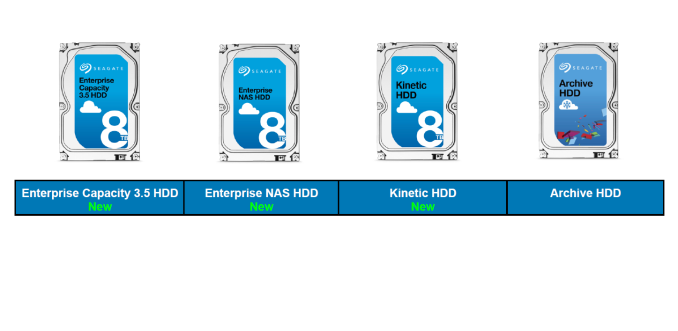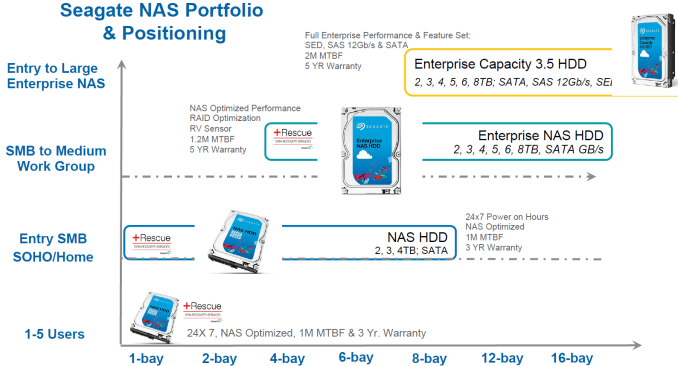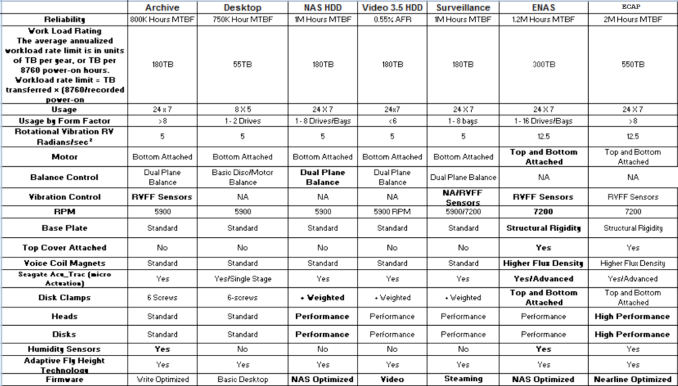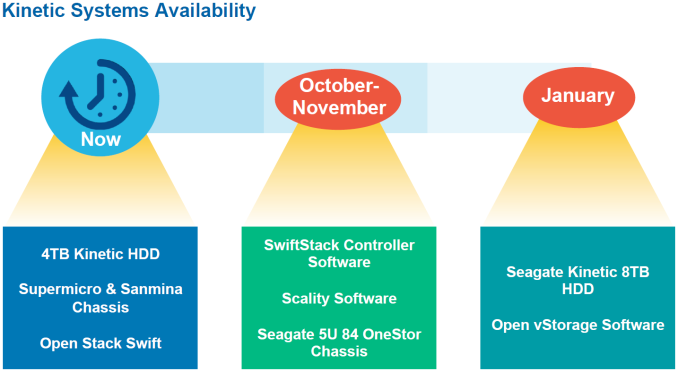Seagate Announces a Trio of 8TB Drives for Enterprise Applications
by Ganesh T S on September 1, 2015 8:00 AM EST
Seagate was the first hard drive vendor to launch a cost-effective 8TB hard drive. The Archive HDD v2 (ST8000AS0002) uses Shingled Magnetic Recording (SMR) to drive up the areal density of the platters and the 8TB version used six 1.33TB platters. The only other 8TB drive currently in the market is the HGST Ultrastar He8, which uses helium filled sealed drives with seven platters.
Seagate is announcing their plans for three new 8TB drives today, mainly targeting enterprise usage. The three 8TB models that join the already existing Archive HDD are:
- Enterprise Capacity 3.5 HDD v5
- Enterprise NAS HDD
- Kinetic HDD
The Enterprise Capacity 3.5 HDD v5 uses traditional PMR (perpendicular magnetic recording) and targets applications such as web, e-mail and SMB servers as well as areas requiring bulk storage. The design uses 6 platters (1.33TB/platter) pointing to an increase in areal density over competing drives. Thanks to the 256MB cache, it provides 100%+ faster random read-writes over the last generation Enterprise Capacity 3.5 HDD v4.
It comes in both SATA 6 Gbps and SAS 12 Gbps versions, and supports Seagate's RAID Rebuild (PDF) feature.
Consistent with the enterprise positioning, we also have a SED (self-encrypting drive) variant.
The other interesting aspects of the Enterprise Capacity 3.5 HDD v5 include power loss protection (needed in part due to the larger cache) and a PowerBalance feature. The latter offers optional trade-off in performance for saving power. However, the firmware programming necessary to activate this feature will be made available only to OEMs and not small scale end customers.
The Enterprise NAS HDD family is also getting the capacity boost to 8TB. The target market is medium to large business customers with requirements for 24x7 enterprise-class storage for mid-range NAS, RAID and cloud applications. This is the same target segment as before (1-16 bay tower / rackmount enclosures). The power consumption of the Enterprise NAS HDD is lower than the corresponding nearline drives. The Enterprise NAS HDD comes with a 5-year optional 'Rescue Data Recovery' service that was discussed in our coverage of the Enterprise NAS HDD launch last year. Like the Enterprise Capacity HDD v5, the Enterprise NAS HDD 8TB version is also based on PMR / 1.33TB/platter technology.
The MTBF, workload ratings and other important characteristics of the various drives offered by Seagate are summarized in the table below.
I had already talked about Kinetic HDDs in our coverage of Seagate at CES 2015. As a recap, the Kinetic HDDs do away with the need for a separate NAS server by presenting two Ethernet links over what looks like a SATA connector. Seagate is sharing some updates today regarding the Kinetic lineup. It is important to note that Kinetic is not a Seagate-only initiative, as Toshiba has also pledged support as a drive vendor for this ecosystem.
As part of the updates, Seagate shared the planned release of the Kinetic OneStor, a 5U 84-bay storage pod, in November this year. In January 2016, the Kinetic HDD 8TB will launch. Unlike the other two 8TB drives being announced today, the Kinetic HDD 8TB will be based on SMR technology.
The two PMR 8TB drives will be available towards the end of October. Seagate did not disclose any pricing information.














14 Comments
View All Comments
DanNeely - Tuesday, September 1, 2015 - link
SMR wouldn't be a show stopper (just put the controller on a different drive); not being able to talk standard file sharing protocols is seems like a bigger issue. At some point I suspect the basic hardware will get cheap enough someone will do it though, just like with the HDDs that have a USB controller baked directly instead of using sata to interface with the enclosure.edward1987 - Friday, January 29, 2016 - link
128MB cache might indicate - working with large file- photo - video editing..you can ask these guys, they know: http://www.span.com/product/Seagate-Archive-HDD-v2...
iwod - Tuesday, September 1, 2015 - link
Slightly Off Topic, We have Toshiba and Intel stating 100TB SSD by 2020, Samsung's roadmap is slightly lower but there is no reason why they cant follow.Seagate's Roadmap were 20TB by 2020. Price / GB for HDD will still likely be 3 - 4x cheaper then SSD ( Today we are HDD is 10x cheaper, assuming both SSD and HDD price dropping in the next few years )
But surely the additional benefits of SSD and TCO will come into play in some stage, and with 3D NAND and Xpoint, we may likely to see the shift in late 2016 or 2017.
How does Seagate intend to stay competitive. Will they speed up the Roadmap ?
DanNeely - Wednesday, September 2, 2015 - link
Depends what you're looking at. In the data center, where space (volume), and power consumption (and fewer copies of data needed due to IO speed????) are a major chunk of the total cost flash is expected to overtake HDDs next year. OTOH a second graph near the very bottom of the study shows the raw price/TB staying in HDDs favor until 2023.What we'll probably see is HDDs in the data center gradually get pushed from default frontline storage to archival data storage only. On the consumer side, I suspect the next year or two will see SSDs infiltrating the race to the bottom laptop segment; leaving HDDs almost exclusively secondary/media storage (either as a 2nd HDD in a desktop or in a NAS of some sort).
The bigger question, and one that the study I'm looking at seems to've ignored, is at what point will shrinking sales levels cut deeply enough into R&D that it slows the rate at which HDD capacity continues to grow. If it hits I could see that shifting the tipping point forward by several years. Once it hits, the HDD market will probably collapse very rapidly.
http://wikibon.org/wiki/v/Evolution_of_All-Flash_A...